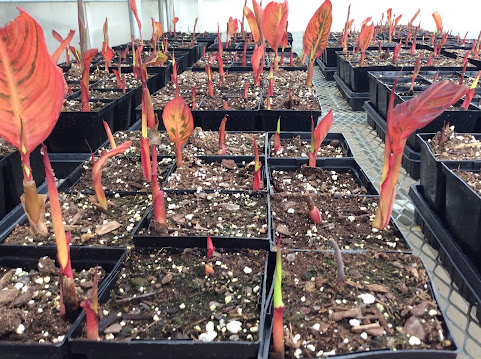We moved into a new home after retiring from our city life. My policy as a gardener is to live life in a new spot for one year before making big gardening changes. It has served me well through the years as I have been able to see and save plants before excavating them from the landscape before I even knew what past residents left behind. Spring bulbs are something that are often lost in our haste to change the landscape.My first tip is this...if you want spring bulbs you plant them in fall. If you want summer bulbs you plant them in spring. The availability at a good garden center will most likely be what you need to be planting that season.
I have two methods for planting bulbs. The first one above is to dig a trench to a depth slightly deeper than the bulbs I am planting. I then add back the soil to the depth that my largest (and deepest bulbs) will need to be planted. I can then lay out the bulbs in the trench to the desired density. In this picture I am planting one variety at one depth. You can use this same method to plant various depth bulbs at a greater spacing, adding soil after each layer until you finish with the smallest bulbs. If you plant in a perennial garden, it is easy to mark where your spring bulbs are by adding some grape hyacinths as they retain foliage through the summer. This will protect your daffodils or tulips that lose their top growth during their rest period.
My second method for planting is using a drill and bulb planter. This is a great method for inter-planting some larger bulbs such as alliums or daffodils among established plants to add some early spring interest before your perennials show up.
If you are in an area that is frequented by wildlife, choose bulbs that are resistant to feeding by deer, rabbits, etc. Bulb companies often mark their packages with this information as well as total height of plant as well as planting depth and spacing. Pay attention to planting right side up so your bulbs are point up through the soil, not down and then having to fight their way up. The top of the bulb often comes to a point. If you are planting roundish bulbs, there will be a more pronounced marking on the bottom of the bulb.
Squirrels and other animals like to dig where you have been digging. If that is the case, laying down some mesh after planting will help decrease their digging. You can lift this up before growth begins in spring. There are also repellents that can reduce animal activity for digging and eating. Read the labels carefully to know how it must be used for effectiveness and safety, what animals it is targeting, and any requirements for reapplication after rain or watering activities. Do not over apply any chemical! They have been tested over years to make sure you are safe and that you don't damage the plants you are trying to protect. More is not always better and less does not always save money.
It may be too late to get some bulbs in where you live because the ground has frozen for the season. If not you can take advantage of bulb clearance bins to add some color to your spring landscape. My best advice is to buy from a reputable garden center. Big box stores have been a source of disappointment for me time and again. I have purchased items promising one plant to have something different come up in my garden. When you want pink lilies and they turn out white the waiting has been a disappointment multiplied. Mail order from a good company can be worthwhile. I have heard from friends this past year that their bulbs shipped well past the optimal planting time when our ground froze before Thanksgiving. It is always best to try and get your bulbs in the ground that season unless you are forcing them indoors. That is a whole set of instructions that I will not cover here.
As we go into the Christmas holiday season, I also begin my next year's plans. The catalogues are already coming...

















